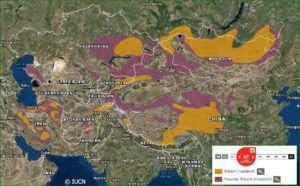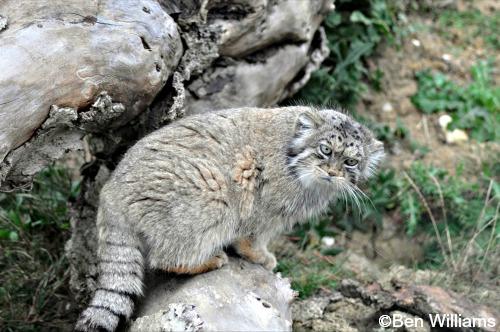- HB Length: 46-65 cm (18-25.5″)
- Tail Length: 20-31 cm (8-12″)
- Height: 30-35 cm (12-14″)
- Weight: 2.5-4.5 kg (5.5 – 10 lbs)
- Pop. Trend: Decreasing
Well-furred cats from the cold Asian steppes, Pallas’s Cats Otocolobus manul are also called Manul, Steppe Cat or Rock Wildcat.
These small cats have a stocky body with thick, soft fur and an abundant dark, woolly underfur which is double the length of that on the rest of the body. The colour varies from a light grey to a yellowish buff and russet, with the white tips of the hair producing a frosted appearance. There are some faint stripes along the sides of the body (more visible on the summer coat), and the fur on the underside is darker and longer than that above. Their head is round and broad with scattered black spots on the forehead, and two distinct parallel black bars on each cheek. The large, owl-like eyes are yellow, and the pupils contract into small circles instead of the usual vertical slits. The ears are short, rounded, and set low on the sides of the head. They are buff on the backs. The legs are short and stout, and the tail is thickly furred with a broad terminal black band, and five to six narrow rings along it.
Distribution

Manul occur in Central Asia, from the Caspian Sea through Iran, Afghanistan, Pakistan and northern India to central China, Mongolia and southern Russia. Populations in the southwest portion of their range – the Caspian Sea region, Afghanistan and Pakistan – are diminishing, isolated and scarce. They are sparse in the Tibetan plateau where an elevation record of 5,050 m was recorded in 2007. Mongolia and Russia now make up the majority of their range.
Populations of Pallas’s cats may vary directly with their prey base and appear to be most numerous where pikas and voles are abundant. Generally, the Pallas’s cat is considered to be widespread but not common across its range and has a fragmented distribution. The largest populations of Pallas’s cats are believed to exist in Mongolia.
Home range sizes are very large for such a small felid. Both sexes maintain home ranges with those of the males overlapping those of several females. In Mongolia, female territories ranged from 7.4-125 km², (average 23km²), while male ranges were 21-207 km² (average 98 km²). The few density estimates done on these cats revealed 4-8 individuals per 100 km².
Habitat
Their habitat is characterized by an extreme climate with little rainfall, low humidity and a wide range of temperatures. Their primarily habitat is the steppe grassland regions of Mongolia, China and the Tibetan Plateau. They have been recorded up to 4,800 m in cold, arid habitats of the dry grassland steppes interspersed with stone outcrops, and in stony desert. These little predators prefer valleys and rocky areas where they have some cover, and avoid completely open habitats. They avoid areas of snow cover that exceed 10 cm, and the continuous snow cover of 15-20 cm marks the ecological limit of the species.
Ecology
Pallas’s Cats look much heavier than they really are due to their stocky build and thick coat. They are well adapted to their habitat. The thick fur coat insulates them against the cold, and the well furred tail can be wrapped around the body like a warm muff. The well developed nictitating membrane (third eyelid) may afford protection against both the cold winds and the regular dust storms which arise in parts of their range. They are able to climb rocky crevices and cliff faces with ease. The flat head and low set ears are thought to be adaptations for stalking prey in open areas with relatively little cover. They hide for much of the day in caves or hollows under stones, or may adopt the burrows of other creatures such as marmots or foxes.
Activity peaks at dusk and dawn, but they may be active at anytime. Their most important prey species is the small pika, which comprise over 50% of their diet. They have three distinct hunting techniques; stalking by creeping around cover; moving and flushing animals out of hiding; and waiting in ambush at rodent burrows.
Body weight varies widely by the season. Females are at their lowest in winter and when raising kittens, males are lowest during breeding season. Their mating call is said to resemble a cross between the bark of a small dog and the hoot of an owl.
Reproduction
Breeding is highly seasonal with mating taking place December-March and kittens born late March-May. The duration of oestrous in females is only 24-48 hours. Gestation has been measured between 66 and 75 days in captivity, and kittens have been born in late April and May in Siberia. The litter size is one to six, usually three or four. Kittens have a dark, woolly coat without the frosted appearance of the adults. The striping on the sides is more pronounced in kittens and fades as they grow. They moult their juvenile coat around two months of age, at which time they weigh 500 – 600 grams. They are independent at 4-5 months, and achieve adult size and weight around eight months of age. Sexual maturity is reached at 9-10 months. Pallas’s Cats have lived up to 12 years of age in captivity.
Mortality is high in this species, with 68% of the kittens not surviving to disperse into their own ranges. Adult mortality is estimated at 50%, with most deaths occurring in the winter months of October-April. Natural predators are known to be large eagles and red foxes.
Threats
- habitat fragmentation and degradation due to overgrazing by domestic livestock and conversion to arable land
- predation by herding/domestic dogs
- mining and infrastructure developments
- prey depletion due to government sanctioned poisoning campaigns for pikas and other rodents in some areas; overexploitation of picas for food and their fur in other areas
- hunted for its fur in large numbers
- demand as exotic pets and used in traditional medicines in Mongolia and Russia
- depletion of marmots which are commonly hunted.Their burrows are used by the cats to provide shelter, avoid predation, giving birth and raising young
Conservation
There have been very few studies conducted about the Pallas’s cat. Recent and ongoing studies from Mongolia and Russia have increased the knowledge base. This includes insight in its ecology and current threats from numerous radio-collared Pallas’s cats in Mongolia. Research has highlighted the importance of improving protection within and outside of protected areas. Despite 12% of the Pallas’s cat’s distribution in Mongolia lying within protected areas, illegal hunting is still frequent in these areas and Pallas’s cat’s large home range sizes may result in the species being difficult to protect within reserves. Protection of Pallas’s cats within reserves in Russia has increased and approximately 13% of the species’ range in Russia lies now within protected areas.
Since 2012, the Pallas’s Cat Working Group (PCWG) has existed as a network consisting of around 30 members from range countries as well as international experts. PCWG aims to unite efforts of specialists in Pallas’s cat study and conservation all over its global range.
In 2016, the Pallas’s cat International Conservation Alliance (PICA) was founded. PICA is a collaboration between the Royal Zoological Society of Scotland, Nordens Ark Zoo of Sweden and the Snow Leopard Trust, funded by Fondation Segré. PICA aims to increase the knowledge on Pallas’s cat distribution and suitable survey techniques, on Pallas’s cat basic ecology, improve awareness and communication, and develop a Conservation Action Plan. The first range-wide Conservation Strategy was developed together with PCWG and published in 2019.
See also Pallas’s Cat International Conservation Alliance
Range Map IUCN Red List (2008)
Updated 2020


7 Responses